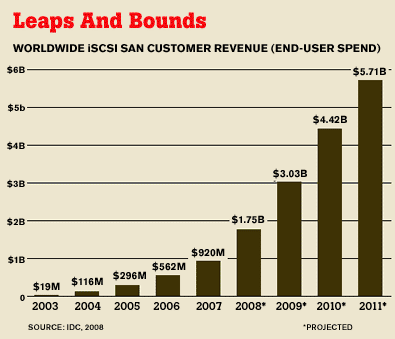Score One For The Little Guy
Solution providers are quick to point out, however, that iSCSI has been moving into the small-business market on its own merits, with that move picking up momentum as customers' data storage needs continue to evolve and they continue to adopt server virtualization.
"It's pretty exciting," said Eryck Bredy, founder and CTO of BNMC Corp., an Andover, Mass.-based small-business solution provider and consultant. "With iSCSI, the small fries are finally getting the storage abilities enjoyed by the large companies for so long."
The storage market is in the midst of a boom in demand for storage products based on iSCSI, which is a storage protocol that allows servers to access SCSI-based devices over an IP network as if they were directly attached to the servers.
IDC, the Framingham, Mass.-based consulting firm, estimates that worldwide revenue for iSCSI SANs will reach $5.7 billion in 2011, up from $920 million in 2007.
Benjamin Woo, a former solution provider and currently a research vice president for enterprise storage systems at IDC, said he expects Dell's acquisition of EqualLogic to make it easier for everybody to bring iSCSI to small businesses.
"People all of a sudden are waking up and seeing that network storage works good," Woo said. "They couldn't afford Fibre Channel. But now they're seeing they can do it with iSCSI."
The key driver going forward will be server virtualization, Bredy said. Server virtualization requires that customers have a SAN in order to migrate and protect virtual servers. And for small businesses, iSCSI is the right solution, he added.
"I like to talk about the 'Zero-U' SAN," he said. "It's a SAN, but it doesn't take any space. A virtual SAN. It has fascinating potential. You need a SAN for server virtualization, and with iSCSI you can now build it out of nothing using software from companies like DataCore [Software Corp., Ft. Lauderdale, Fla.]."
Woo said he expects server virtualization to be the "killer app" for iSCSI. "We can do quality of service on a virtual machine, but not with Fibre Channel without some add-ons," he said. "But with Ethernet, we can look at the quality of service of a virtual machine."
For now, the key driver of iSCSI storage growth—especially in small businesses—is the relatively low cost to build a SAN when compared to the main alternative technology, Fibre Channel.
Next: The Myth OF Fibre Channel The Myth Of Fibre Channel
Several vendors, including traditional enterprise-class storage vendors such as Hewlett-Packard Corp., Palo Alto, Calif.; Network Appliance Inc., Sunnyvale, Calif.; and Dell, are offering iSCSI-based arrays starting at well under $5,000. iSCSI serves storage over a company's existing LAN.
The lower cost of iSCSI more than balances the perceived benefits of Fibre Channel—such as scalability and performance—for small businesses, said Dhruv Gulati, executive vice president of Lilien Systems, a Larkspur, Calif.-based solution provider. "Small businesses have the storage budget, but it's more suitable for iSCSI than Fibre Channel," Gulati said.
The performance benefit of Fibre Channel, which transmits data at 4 Gbps compared to Gbit Ethernet, is usually a myth because most businesses don't send enough data over their networks to fill the pipelines, Bredy said.
"If you have a 4-inch pipe vs. a 1-inch pipe, sure, you can pour more water through the 4-inch pipe," he said. "But the bottleneck is elsewhere. At the end of the day, what's important is how you manage your pipeline, not the width of the pipeline."
Most companies already have 100-Mbit or Gbit Ethernet networks, which are just fine for building an iSCSI SAN, Gulati said. "They may have to add a couple of switches. But that's the beauty of iSCSI."
Part of the affordability of iSCSI comes from the widespread availability of Ethernet networks, a relationship that will continue to grow as customers in the next few years start adopting 10-Gbit Ethernet, Woo said.
In the end, he added, the growth of iSCSI will come from customers and their solution providers leveraging their Ethernet infrastructures.
"Small businesses have people with expertise in Ethernet," Woo said. "They don't need to tune it like they do for Fibre Channel."
iSCSI requires initiator software on the server host and target software on the storage array, both of which are commonly offered today. The host and storage device can then connect over the LAN to pass and share data.
It's actually pretty easy, said Kip Lindberg, vice president of enterprise sales at Ncell Systems Inc., a Minnetonka, Minn.-based solution provider.
"The beauty is, you don't need a system administrator," he explained. "You can stumble through it, if needed. It's not 'storage for dummies.' But it's not difficult."
While mature IP technology has made the building of an iSCSI SAN simple compared to the complex nature of Fibre Channel, iSCSI is by no means idiot-proof, Bredy said.
"Customers still need their system integrators," he said. "When you bring them a storage network, you bring it in for disaster recovery or consolidation. So you need to meet their business needs. Setting up iSCSI itself is pretty simple. But to tie it into business requirements, you need us, the VAR, to help."
